Solar is at the forefront of climate mitigation efforts, but comes with some environmental baggage of its own.
One concern is the amount of land needed for the energy revolution, especially as more utility-scale solar projects are brought forward.
For example, in July developers of a proposed 850 MW solar plant in the desert north of Las Vegas pulled their application with the Bureau of Land Management in the wake of local opposition. Residents argued that the array, proposed to cover more than 14 square miles, would be an eyesore and could hurt area recreational activities.
A study by Clemson University estimated that energy production for domestic use and export will rise by 27% by 2040. Roughly 124,000 square miles of land will be needed to site all of the related facilities. With spacing requirements included, nearly 500,000 square miles of land will need to be dedicated to new energy production, an area larger than Texas.
To be sure, the built environment (rooftops, carports, and the like) are common places for solar installations. The benefits of these distributed sites are numerous. But if the nation is to rapidly hit clean energy penetration targets, then large-scale projects with big footprints are needed as well.
Not all large-scale solar deployments need to be sited on vacant spaces or farmland, however. Three options include floatovoltaics, landfill solar, and highway rights-of-way. Let’s have a look at each in turn.
By land or by sea?
Floatovoltaics are a hot PV trend set to double in capacity in 2021. The structures largely take land use debates off the table as the solar array floats on top of a body of water. Typically, these installations are found buoyed-up on a lake or basin, where the water is calmer than the ocean.
Dual-use locations are often a site for these projects. Reservoirs, hydroelectric dam water sources, and wastewater treatment ponds are all potential candidates to host floatovoltaics.
Take the Far Niente Winery in Napa Valley, California, for example. Completed in 2008, it is widely considered to be the first grid-connected floatovoltaic array in the world. To meet annual demand of 800,000 kWh, the solar array uses 2,296 panels, 1,200 of which sit on top of the winery’s irrigation reservoir, reserving nearby vineyard space for grape production.
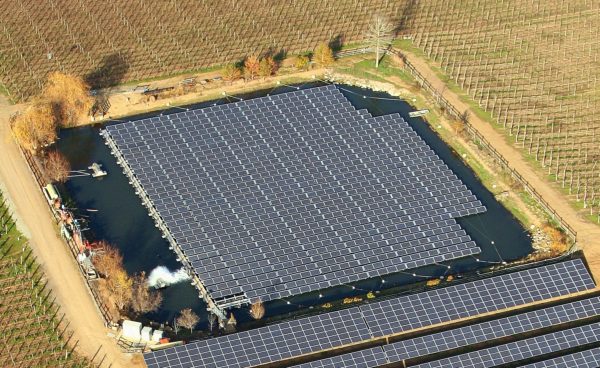
Image: Wikimedia Commons
The buoyant structure that supports the panels was a simple, yet clever solution. Pontoons made of 18-inch ribbed pipe filled with Styrofoam sit beneath the panels and are attached to four concrete mounts. The array can freely rise and fall 18 feet as water is used, and the concrete mounts prevent the modules from rotating and ensure an optimal azimuth.
What’s more, the array reduces evaporation by covering and cooling the water. This same effect also prevents the spread of unwanted algae. In turn, the pond benefits the panels, acting as a stable thermal mass that regulates temperature, slowing panel degradation and increasing efficiency.
An example of how such projects be effective comes from the Sembcorp Floating Solar, a 60 MW FPV array on the Tengeh Reservior in Singapore, which recently entered service. The system’s 122,000 Trina Solar 210 Vertex dual-glass modules, which cover a surface area the size of 45 football fields, deliver green energy from Singapore’s main reservoir of drinking water via a 25-year power purchase agreement (PPA) with the National Water Agency.
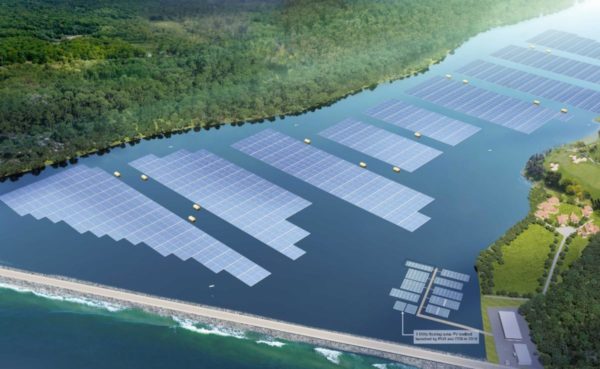
Image: Sembcorp
Singapore’s Public Utilities Board said it selected the Trina solar modules due to their double-glass protection, which will aid in making them durable enough to perform in wet and humid conditions for 25 years. The panels are supported by high-density polyethylene (HDPE) floats. The floats are UV-resistant, a necessity to protect them from degradation.
When evaluating the effectiveness of floating PV, cost is likely a first concern as these structures have unique construction mounting (or docking) needs. However, cost parity may be closer than one may expect.
FPV has slightly higher capital costs, but lower operation and management (O&M) costs, no land costs, and increased efficiency benefits the cost structure.
According to Stetson Tchividjian, director of business development at D3Energy, an FPV developer, the price to install floating solar is about 10% to 15% higher than land-based PV. However, O&M cost reductions may help close the gap. If the externalities that stem from developing otherwise-useful land are included, then the economics behind floating solar may keep a project above water.
Landfills full of opportunity
Landfills and other contaminated brownfield sites are another area for growth. The U.S. Environmental Protection Agency tracks solar-landfill topping installations as part of its RE-Powering America’s Land initiative, and has recorded an 80% rise in installations in the last five years. Nearly 60% of the tracked projects sit on landfills, and more than 90% of the RE-Powering projects are solar PV.
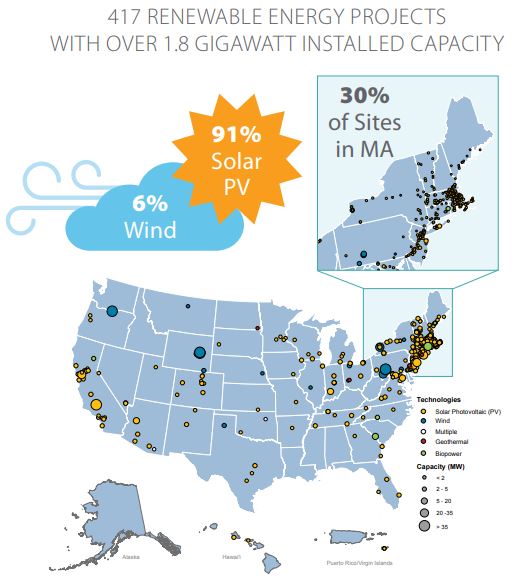
Image: EPA
Most of the sites are either municipally or privately owned, with about 1.5 GW of the 1.8 GW installed capacity falling under those ownership structures. Two-thirds of the projects sell power back to the grid, and 22% of the tracked sites are community solar projects. Nearly 70% of these facilities offer 1 MW or more of capacity.
Massachusetts currently leads the field with 30% of the country’s landfill projects. EPA said that a favorable policy climate is important to supporting brownfield sites. Massachusetts’ SMART Program offers enhanced incentives for landfill and brownfield development and built a fast-track for the approval process of these projects, hence the state’s leadership in this arena.
New Jersey and Illinois have also made strides in policy and utility involvement, said the EPA.
One of the largest is the 50 MW Sunnyside solar facility, planned to top a 240-acre Houston landfill and enter service by the end of 2022. Sunnyside’s procurement came as a result of the city’s Climate Action Plan.
Typically, installers are not allowed to penetrate the landfill’s surface, and mounting hardware and foundational structures must be adaptable and lighter than in a conventional ground-mount design. For example, mounting supplier Solar FlexRack provided cast-in-place racks for a community solar landfill development south of Provo, Utah. The mounting system used lighter ballasts with internal bracing and fewer components than a typical solar mount.
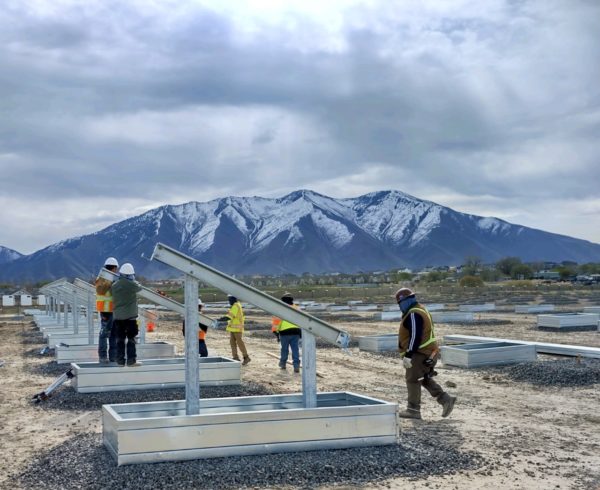
Image: SolarFlexRack
Lighter mounts, less expensive land, and environmentally minded policy are all drivers that can push costs down for solar landfills.
Highway PV
Highway right of way (ROW) areas offer unique qualities that lend themselves to solar installations. For example, the Colorado Department of Transportation (CDOT) explained that ROW areas offer ease of access to the adjacent solar facilities and transmission lines often follow highway alignments. What’s more, ROWs have well-maintained vegetation and few trees or other shading elements.
The CDOT study noted a number of potential safety and quality issues with ROW PV. The top concerns included snow drift and deposition, panel glint and glare, water quality management issues, driver safety in collisions, and safe access for maintenance.
As a result of the study, CDOT created a series of tools for properly siting solar projects. The tools included glint and glare hazard models, array siting criteria, an impact matrix and mitigation strategies.
Highway ROW solar has been deployed in Europe for more than 30 years, and innovations continue to be introduced. For example, a Belgian consortium created two testing facilities to develop PV-equipped noise barriers for use where land and policy constraints make ground-mounted solar plants nearly impossible to install.
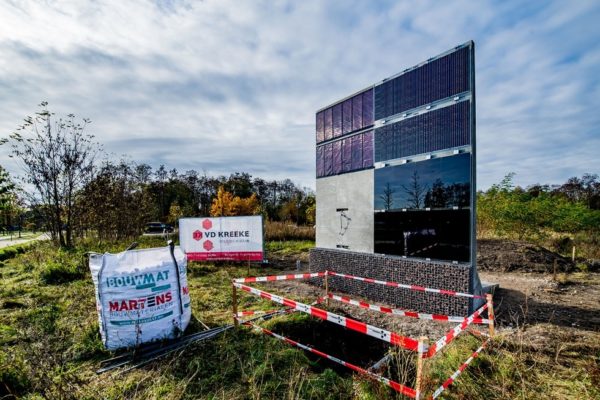
Image: Rolling Solar
The dual-use structure must first function as a sound barrier, which may limit the accompanying PV production. Modules are covered with a transparent sound dampening layer that the researchers said cut production by about 30%.
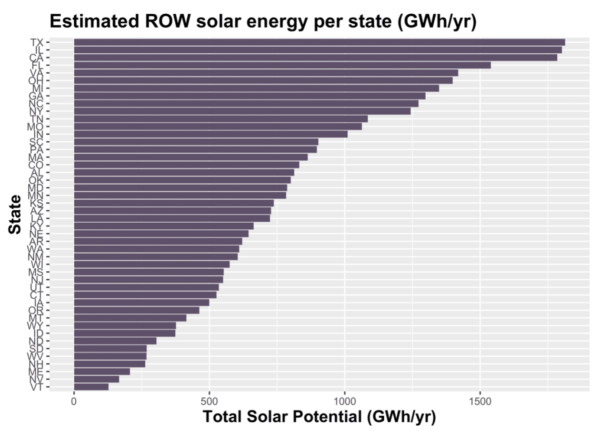 In the U.S., the land area available for ROW installations can be tight and is generally best left for highway interchanges and exits, according to a study by the University of Texas at Austin’s Webber Energy Group.
In the U.S., the land area available for ROW installations can be tight and is generally best left for highway interchanges and exits, according to a study by the University of Texas at Austin’s Webber Energy Group.
The study found that most states have more than 200 miles of suitable interstate frontage available. That amounts to between 440 and 6,600 acres of preferable install site area per state. Each state had an identified potential of anywhere from 127 to 1,814 GWh per year, with Texas sitting in the top spot. California and Illinois ranked second and third in potential.
The Texas researchers identified a need for GIS data to better support the development of ROW solar. Iowa was the only state included in the that had completed detailed highway interchange profiles to facilitate the transition to solar site planning.
This content is protected by copyright and may not be reused. If you want to cooperate with us and would like to reuse some of our content, please contact: editors@pv-magazine.com.
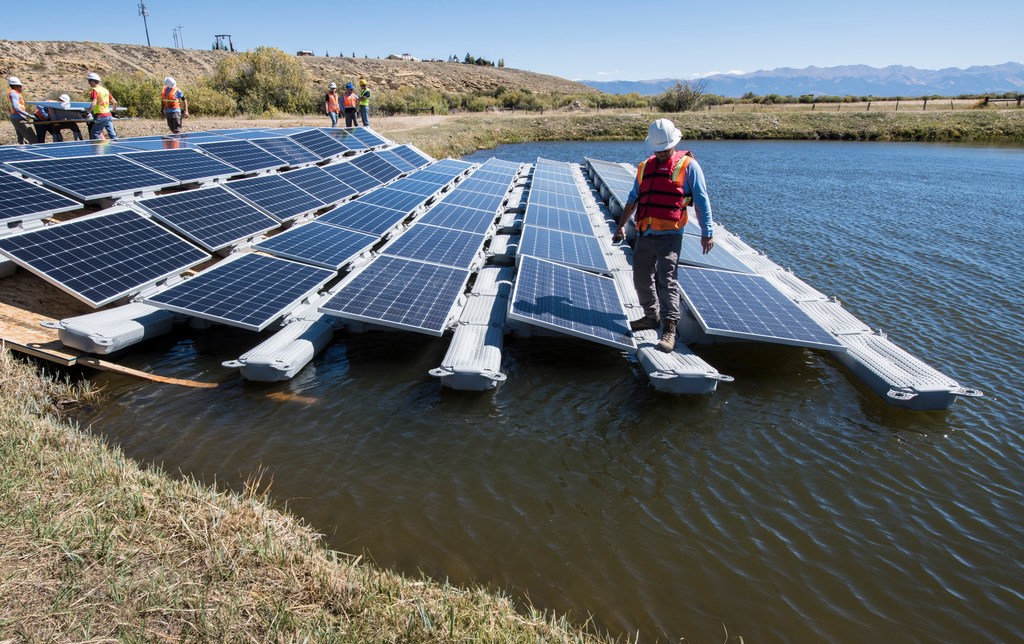








Why do articles not include agrivoltaics?
It can be used to grow food and/or energy crops under the panels.
Hi Robert, please check out some of our articles about agrivoltaics here:
https://pv-magazine-usa.com/2021/01/06/could-agrivoltaics-feed-our-demand-for-clean-energy/
https://pv-magazine-usa.com/2021/08/05/researchers-develop-a-novel-design-for-agrivoltaics/
https://pv-magazine-usa.com/2021/04/06/pine-gate-develops-agrivoltaics-plus-storage-at-massachusetts-cranberry-bogs/
The thing is we are 15 years behind schedule if we want to be on track to keep our international commitments towards zeroing emissions. Being picky about siting slows things down, and it belies the urgency of our circumstances and situation. It is also often driven by bad understanding of science and of the natural constraints which fields and forests suffer in their sequestration of Carbon. They also don’t appreciate that damage to climate is effectively irreversible.
People can choose to do anything they want, but there is a price to be had if going slow.
Really interesting article. President Biden has set some ambitious targets for solar generation in the US. It will be interesting to see fast things can ramp up. The rapid roll out of solar and the reduction in costs offers hope for the future.
Great read. Fascinating technologies being deployed, especially the mounting system in Napa Valley winery.